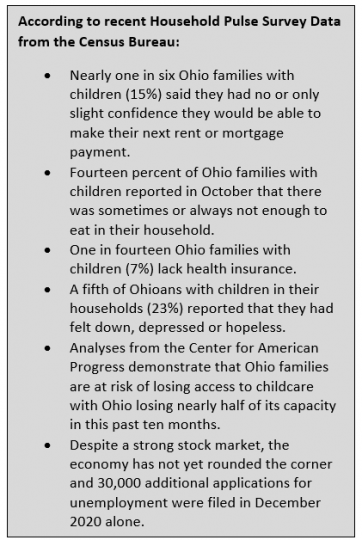 Ohio’s 2022-2023 State Budget Must Advance a Whole Child Agenda to Help Our Communities Thrive
Ohio’s 2022-2023 State Budget Must Advance a Whole Child Agenda to Help Our Communities Thrive
February 4, 2021
By Alison Paxson, Policy Associate
The COVID-19 and economic crisis experienced over the last ten months has disproportionately harmed our most underserved populations and communities. Further, the looming K-shaped recovery does not bode well for us all getting through this together.
Our children are paying the price, and they deserve better.
They deserve an Ohio where the stress, isolation, and trauma of this moment is met with investments that prioritize their mental and behavioral health, where their caregivers are not thrust into impossible choices and even out of the workforce due to unaffordable child care options, where their educational opportunity is not determined by their zip code, race, ethnicity, or ability, and where all babies reach their first birthdays and their families are supported to have economic stability, quality healthcare, and opportunities as they grow and develop and flourish into adulthood.
Ohio’s 2022-2023 state budget is an opportunity to build the thriving communities that our children deserve.
Last week, the Ohio Legislative Children’s Caucus met for the first time this year, as a new general assembly with both new and returning leadership, to discuss how the legislature can advance a whole child budget agenda this biennium.
Their policy priorities for the next biennium center on these four areas critical to child wellbeing:
- Equitable K-12 School Funding
- High Quality Child Care and Early Education
- Child Mental and Behavioral Health and Social Emotional Wellness
- Continuum of Care for Mothers and Infants
To discuss these priorities, the Caucus welcomed a panel of presenters from the Ohio Children’s Budget Coalition (OCBC) to address their recommendations for the state budget to create a shared vision of child wellbeing in Ohio. CDF-Ohio’s executive director was honored to take part in this discussion which included presentations from:
- Tracy Nájera, Executive Director, Children’s Defense Fund-Ohio
- Lynanne Gutierrez, Assistant Director and Legal Counsel, Groundwork Ohio
- Will Petrik, Budget Researcher, Policy Matters Ohio
- Scott DiMauro, President, Ohio Education Association
On Monday, Ohio’s governor Mike DeWine and his administration unveiled their proposals in the executive budget for the 2022-2023 biennium. Where did the Governor’s budget align with their recommendations for a whole child budget agenda?
| High Quality Child Care and Early Education |
| What was in the Governor’s Executive budget?
The Governor announced that his administration is proposing an increase in initial income eligibility for publicly funded child care from 130% to 138% federal poverty level (FPL) (up to 150% for children with disabilities). |
| Why is this important?
Ohio currently has the second lowest initial income eligibility threshold in the country – only behind Indiana. While this is an important step, it still leaves Ohio’s income eligibility threshold too low and does not adequately address child care accessibility and affordability for Ohio’s working families. |
| We also recommend that we further support access to high quality child care and early education by:
· Expanding initial income eligibility for publicly funded child care to 200% FPL. · Ensuring children receive quality care by supporting a highly skilled and fairly compensated early childhood workforce. · Increasing state investment in publicly funded child care in order to support the increased cost of operations and to recover lost capacity due to COVID-19. We need to ensure our child care system has stabilized and sustainable funding mechanisms into the future. |
| Child Mental and Behavioral Health and Social Emotional Wellness |
| What was in the Governor’s Executive budget?
One of the most significant items we saw in Governor DeWine’s executive budget is the increase in Student Wellness and Success funding (line item: 200604) by $100M per fiscal year (totaling $1.1 billion over the biennium) to support wraparound services for students in K-12. |
| Why is this important?
This is particularly important now due to the stress, isolation, trauma, and instability experienced by many children as a result of the COVID-19 pandemic. This funding is allocated directly to school districts to support them in their community partnerships to ensure all children have access to mental health professionals, counseling, mentoring, and other supportive services. |
| We also recommend that we further support child mental and behavioral health by:
· Implementing more tools and greater data collection on the unmet needs in child mental and behavioral health throughout Ohio. · Elevating access to these services by creating a better workforce development pipeline. |
| Equitable K-12 School Funding |
| What was in the Governor’s Executive Budget?
The Governor decided not to include the Fair School Funding plan in his budget, instead leaving this important work to implement and invest in a more equitable and just school funding formula to the state legislature. |
| Why is this important?
While the significant increase in wraparound services for school districts will be helpful in meeting the social emotional needs of their students, school districts still need to be adequately funded over the biennium and beyond. In the coming months, legislators will need to continue their work to create a constitutional and equitable school funding system = for all Ohio students in the next phases of the budget process. |
| We also recommend that we further support a more equitable education system in Ohio by:
· Funding more studies to improve funding and educational outcomes for students in poverty, with special needs, in rural districts, and who are English language learners. · Creating a school funding oversight committee to support policymakers in making adjustments and modifications to the school funding formula. · Creating a Permanent School Fund for long-term funding stability. · Utilizing one-time federal funds to respond to immediate needs from COVID-19. |
| Continuum of Care for Mothers and Infants |
| What was in the Governor’s Executive budget?
The Governor’s executive budget invests an additional $2 million in the Help Me Grow program (a 5% increase over the biennium in line item: 440459) to increase support for evidence-based home visiting programs in Ohio. In addition, the budget proposes a funding increase in Infant Vitality (line item: 440474) for FY2022, to identify women early in their pregnancies who may be at-risk and need greater support for healthier deliveries. |
| Why is this important?
In Ohio, half of all maternal deaths are preventable, and we continue to rank as one of the worst states in the nation in infant mortality indicators. In maternal and infant health, the Governor’s budget continues to critically prioritize mothers and their babies by addressing infant mortality and maternal morbidity. |
| We also recommend that we further support continuum of care for mothers and infants by:
· Expanding the current 12 month continuous care waiver to include women with high-risk pregnancies and the Ohio Department of Medicaid should apply for an 1115 demonstration waiver to access federal funds for Medicaid services. · Increasing access to doula services for pregnant women to reduce incidences of preterm birth and reduce the likelihood of maternal morbidity and infant mortality, especially for women of color. |
Ohio’s state budget decisions have the power to either address the inequities in our society, laid bare by the upheaval of a global pandemic and an economic recession, or deepen them further. CDF-Ohio will be following the budget process closely, releasing more information in the near future on how the Governor’s budget aligns with the full scope and areas of whole child wellbeing. We look forward to working with our state’s leaders to advance a whole child budget that builds an Ohio that our children deserve.
To access a recording of the Children’s Caucus meeting, please visit their YouTube Channel.
For a full list of recommendations for the 2022-2023 budget from the Ohio Children’s Budget Coalition, please visit their website.

